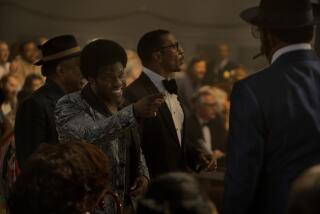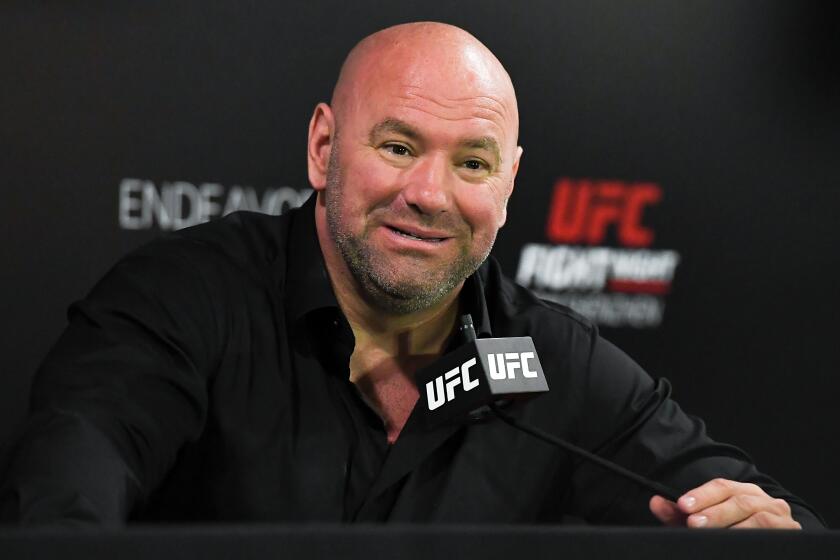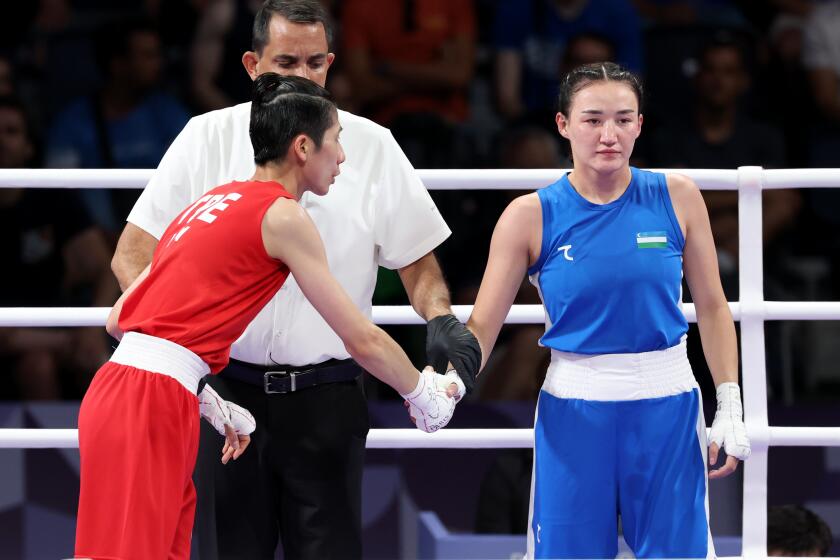The Fight of the Century 20 Years Ago
It was a different world then, in boxing and in everyday life. On March 8, 1971, Richard Nixon was nearly through his first term as president. John Lindsay was mayor of New York City. A gallon of gasoline cost about 30 cents and for $1.50 you could see a double feature at any of two-dozen “respectable” movie houses on 42nd Street between Broadway and Eighth Avenue.
And at Madison Square Garden, Joe Frazier and Muhammad Ali were preparing to fight for the undisputed world heavyweight championship in one of the first of the many bouts dubbed “The Fight of the Century.” In an era when major-league baseball players barely had reached the $100,000-per-year milestone, Frazier and Ali would split a record $5 million in a bout that would sell out the Garden and rivet more than 200 million people before television screens around the world.
Two decades later, spanning the rise of Sugar Ray Leonard to the rebirth of the Rev. George Foreman, other fights may have surpassed Ali-Frazier I in terms of revenue but none has come close to its drama, anticipation or mass appeal.
“If they had dropped a bomb on the Garden that night,” said Gil Clancy, who worked Frazier’s corner, “the United States would have stopped running, there were so many celebrities and officials there.”
Part of the mystique was because “The Fight,” as it came to be known, was one of the first to be blacked out on radio and home television, and there was to be no delayed broadcast. Fight fans without the money or the connections to get one of the red-hot ringside tickets had to fork over anywhere from $5 to $25 to watch the closed-circuit telecast on a grainy, dim movie screen, or settle for the 100-word wire-service synopses that went out over the radio after each round, despite the promotion’s best efforts to squash them.
The bigger part of the mystique was due to the fighters themselves. Frazier-Ali I was the best match-up boxing could offer, in any weight class. Two unbeaten heavyweight champions -- Ali had been stripped of his title in 1967 for refusing induction into the Army -- one a brilliant boxer and the other a feared slugger. Two men of vastly different personalities, one outgoing, glib and humorous, the other serious, quiet and with a smoldering pride. Ali was the symbol of the counterculture, hated and feared by many establishment whites. By default, Frazier became an unwilling “Great White Hope,” vilified by Ali and his militant following.
The chemistry was explosive enough to make Ali-Frazier I by far the richest and most eagerly awaited sporting event to that time. More important than their greatness as fighters, Ali and Frazier were pioneers, as much as Curt Flood in baseball and Joe Namath in football. The first Ali-Frazier fight changed the wage scale for fighters and it changed forever the way boxing matches were presented and financed. No longer would boxers’ earnings be limited by the size of the live gate -- closed circuit, and later, casino money, would open up a whole new financial universe.
When a 29-year-old Ali returned to the ring in 1970 after 43 months in exile, all roads led to Frazier and the Garden, which offered the fighters a guaranteed $1.25 million each against a percentage of the revenue. Garden matchmaker Teddy Brenner says neither Frazier nor his late manager, Yank Durham, had a clue about how to write down so large a number. “Frazier had too many zeroes,” Brenner said. “And Durham never did figure out where to put the comma.”
Their problems were solved, however, when they accepted the offer by millionaire sportsman Jack Kent Cooke, and his partner, a Hollywood hustler named Jerry Perenchio, who paid each fighter a flat $2.5 million, but no percentage of TV revenue. When the projections were announced at the contract signing -- a potential audience of 300 million people watching in 50 countries -- Ali looked at Frazier and screamed: “We been took!”
If he only knew. Although it worked out to the satisfaction of the promoters -- Frazier-Ali I drew a crowd of 20,455 and a Garden-record gate of $1,352,951 -- the fighters came up a bit short. Had they taken the original deal offered by Brenner and Garden boxing boss Harry Markson, Ali and Frazier would have each made 32.5 percent of the announced $20 million worldwide gross -- or $6.5 million.
When first announced, the ticket prices -- $150, $100, $75, $50, $40, $20 -- were considered outrageous. But the clamor was such that within days the fight was sold out. People offered $1,000 a ticket and Hugh Hefner tried, unsuccessfully, to have the fight piped into the Playboy mansion for $2,500. By fight night, scalpers were getting that much for one ringside seat.
“We could have charged $1,000 a ticket, easy,” Brenner said. “It became a ‘Don’t-miss-it’ event. Everyone was there, J. Edgar Hoover, the Kennedys, Diana Ross, Woody Allen. The crowd was split between people who thought Ali was the victim of a terrible injustice and the people who wanted him to get his block knocked off.”
Desperate fight fans came up with all sorts of novel ways to crash the gate. One man made it into the arena with two pairs of boxing gloves that he had somehow passed off as the weapons for the main event. His quest ended, however, when he ran into the late John Condon, then the Garden’s head publicist.
“I’m assigned to bring the fighters their gloves,” the man told Condon. “Here they are. And I’m going to have to ask you to stand aside. Time is of the essence.”
“It sure is,” Condon said. “They’re already in the second round.”
The panicky television producers, who never had done a fight, staged a “dress rehearsal” in the Garden ring the afternoon of the fight, with Harold Weston imitating Ali, some long-forgotten fighter doing Frazier, and Clancy serving as the referee. To add to the bizarre scene, Ali -- who was locked in the Garden all day after the morning weigh-in for fear he would be mobbed by the crowds massed outside if he tried to return to his hotel -- provided running commentary from the empty bleachers.
Somehow, the fight lived up to its hype. Ali, still a bit short in conditioning having had just two tuneups, started well but began to fade by the fifth round under Frazier’s relentless pressure. Still, he tried to negate the effects of Frazier’s punches by mugging for the crowd and shaking his head whenever he was hit solidly. In the ninth and 10th Ali rallied, but the turning point came in the 11th, when a Frazier hook turned Ali’s legs to jelly. He barely survived the round and wobbled through the next two. Although he boxed well to win the 14th, Frazier decked him with a left hook early in the 15th to close the show.
Frazier’s win was unanimous -- 9-6, 8-6-1 and 11-4 -- and for the first time in his career, Ali skipped a postfight news conference to have his swollen jaw X-rayed. Frazier spoke briefly but spent the next week in the hospital suffering from dehydration and kidney damage. Ali had promised to crawl across the ring and kiss Frazier’s feet if he lost, but in the ring after the final bell, Frazier told him, “We’re both great. We don’t do no crawling.”
They met two more times, Ali winning a decision in a clinch-marred non-title bout in 1974 and stopping Frazier after 14 rounds of the so-called “Thrilla in Manila,” a great battle between two spent warriors. But never again did they capture the public’s imagination the way they did the first time around.
After all, there can be only one true “Fight of the Century” per century.
More to Read
Go beyond the scoreboard
Get the latest on L.A.'s teams in the daily Sports Report newsletter.
You may occasionally receive promotional content from the Los Angeles Times.










